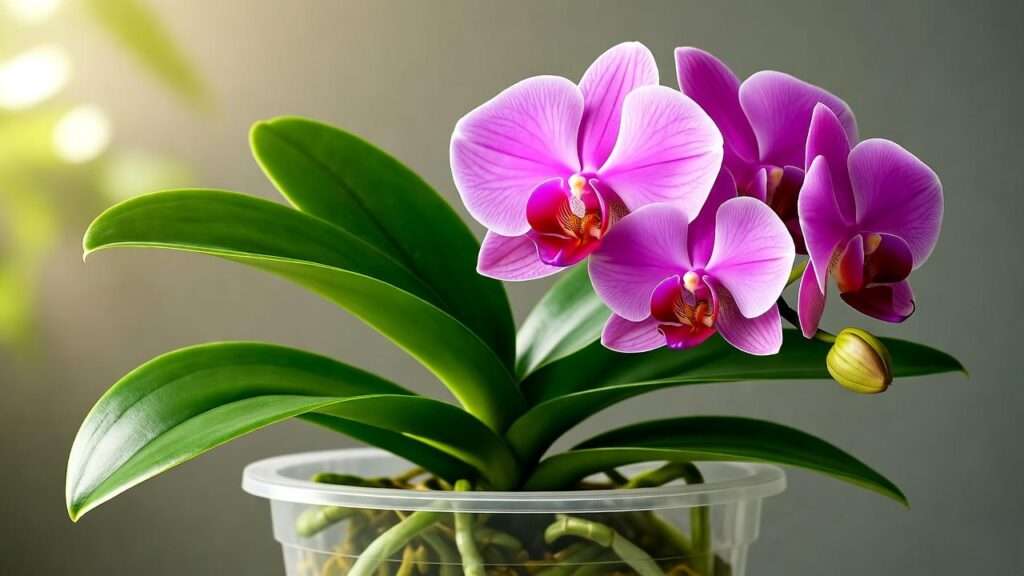Picture this: your orchid’s vibrant blooms are the centerpiece of your home, turning heads and sparking joy with every glance. But then, those lush petals droop, and the roots turn mushy — all because of one common mistake: improper watering. Learning how to water an orchid plant correctly is the secret to keeping these delicate beauties thriving. As a horticulturist with over a decade of experience nurturing orchids, I’ve seen firsthand how proper watering transforms struggling plants into flourishing showstoppers. In this comprehensive guide, you’ll discover expert techniques, avoid common pitfalls, and unlock the secrets to vibrant, long-lasting blooms. Let’s dive into the art and science of orchid care!
Understanding Orchid Watering Needs 🌱
Orchids aren’t your average houseplants. Their unique biology demands a tailored approach to watering, and understanding these needs is the foundation of healthy plants.
Why Orchids Are Unique
Orchids, often epiphytes in their natural habitats, grow on trees or rocks, not in soil. Their thick, spongy roots absorb moisture and nutrients from the air and occasional rain. This means they thrive in airy, well-draining environments, unlike typical potted plants. Popular varieties like Phalaenopsis (moth orchids), Cattleya, and Dendrobium each have slightly different preferences, but all hate soggy conditions. For example, Phalaenopsis prefers slightly more moisture, while Dendrobium thrives in drier settings. Knowing your orchid’s type helps tailor your watering routine for optimal growth.
The Risks of Improper Watering
Watering mistakes are the leading cause of orchid woes. Overwatering can lead to root rot, yellowing leaves, and plant death — a heartbreaking sight for any plant lover. Conversely, underwatering causes wilting, shriveled roots, and a lack of blooms, leaving your orchid looking sad and stunted. For instance, a friend once overwatered her Phalaenopsis, assuming daily watering was best. Within weeks, the roots turned mushy, and the plant wilted. By understanding proper techniques, you can avoid these pitfalls and keep your orchid thriving.
Expert Tip: Always check the potting medium before watering. If it’s still damp, hold off to prevent waterlogged roots.
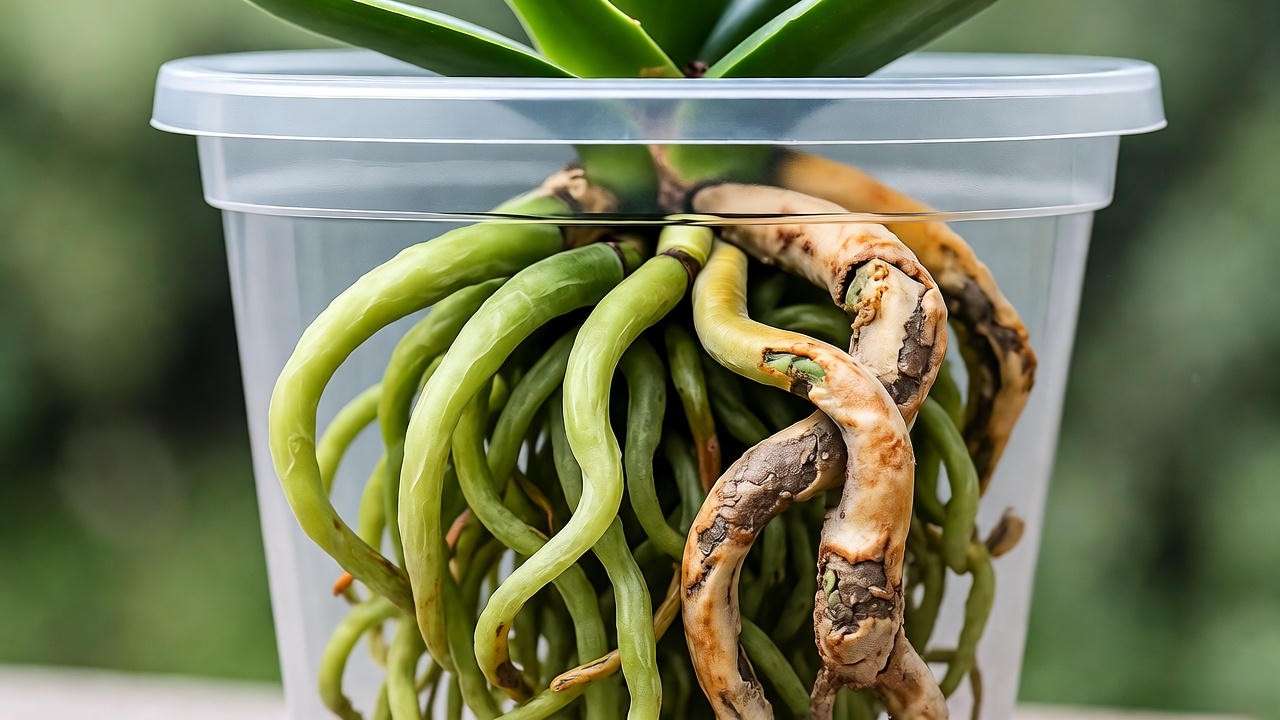
When to Water Your Orchid ⏰
Timing is everything when it comes to watering orchids. Unlike other plants, orchids don’t follow a strict schedule. Instead, their needs depend on visual cues and environmental factors.
Signs Your Orchid Needs Water
Healthy orchid roots are your best guide. Look for these signs:
- Dry, silvery roots: When roots turn grayish or silvery, it’s time to water. Green, plump roots indicate sufficient moisture.
- Dry potting medium: If the bark or sphagnum moss feels dry to the touch, your orchid is ready for a drink.
- Lightweight pot: Lift the pot — if it feels significantly lighter than after watering, it’s time to hydrate.
For example, my Phalaenopsis roots turn silvery after about 8 days in my low-humidity home, signaling it’s watering time. Observing these cues ensures you water only when necessary.
How Often Should You Water?
A general rule is to water every 7–10 days, but this varies based on:
- Humidity: Low-humidity environments (below 50%) require more frequent watering.
- Temperature: Warmer conditions dry out the medium faster.
- Pot size and type: Smaller pots and bark-based media dry out quicker than moss.
- Orchid variety: Phalaenopsis may need weekly watering, while Cattleya can go 10–14 days.
Adjust for seasons, too. In winter, when growth slows, reduce watering to every 10–14 days. During the active growing season (spring and summer), weekly watering is often ideal.
Pro Insight: Insert a wooden skewer into the potting medium. If it comes out dry, it’s time to water. This trick ensures you’re not guessing!
How to Water an Orchid Plant the Right Way 💧
Now that you know when to water, let’s master how. Proper technique ensures your orchid gets just the right amount of moisture without risking root damage.
Step-by-Step Watering Process
Follow these steps for perfect watering every time:
- Use room-temperature water: Cold water shocks roots, while hot water can harm them. Aim for 65–75°F (18–24°C).
- Water thoroughly: Pour or soak until water flows freely from the drainage holes, ensuring all roots are hydrated.
- Drain completely: Never let the pot sit in standing water, as this leads to root rot. Empty saucers immediately.
- Check the crown: Ensure no water pools in the center of the leaves (the crown), as this can cause rot. Use a paper towel to dab away excess.
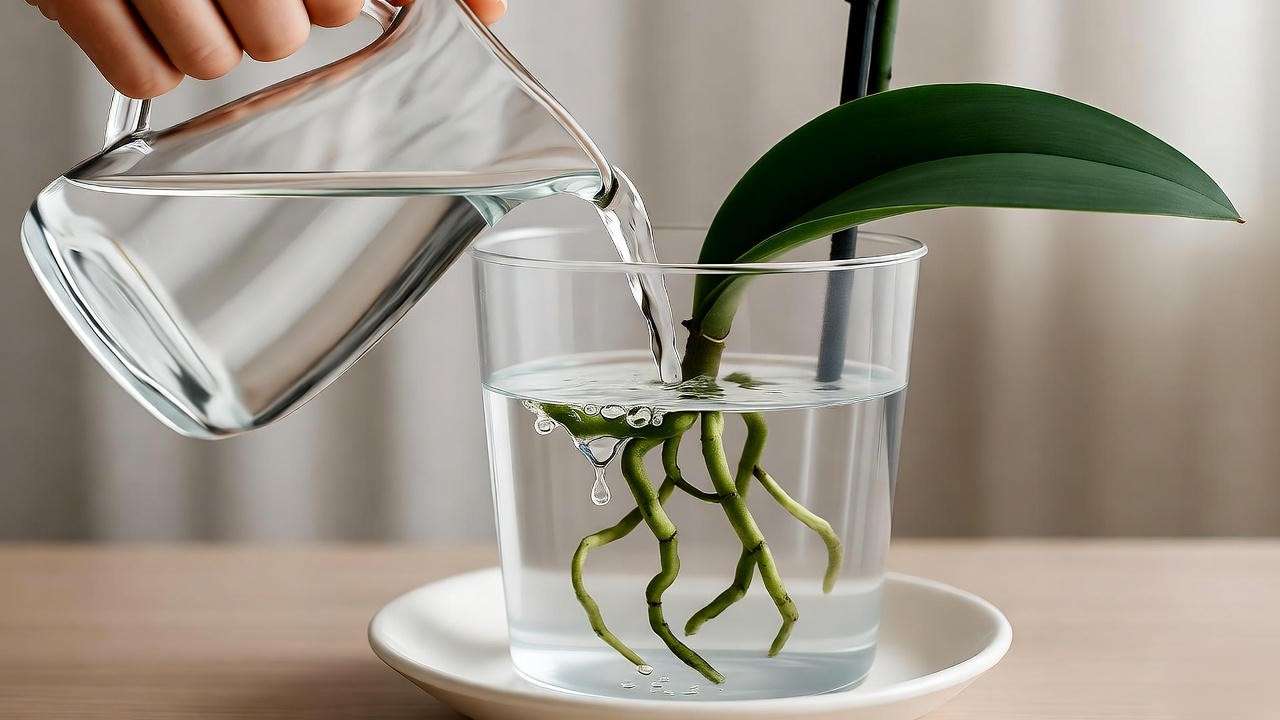
Best Watering Methods for Orchids
Choose the method that suits your orchid and lifestyle:
- Soaking method: Submerge the pot in a basin of water for 10–15 minutes, then drain thoroughly. Ideal for bark-based media.
- Pour-through method: Slowly pour water over the medium until it drains out the bottom. Great for quick watering sessions.
- Misting: Lightly mist roots in very dry environments, but avoid misting leaves to prevent fungal issues.
For example, I soak my Phalaenopsis every 10 days, letting it sit in a bowl of rainwater for 15 minutes. This ensures even hydration without overdoing it.
Choosing the Right Water
Water quality matters for orchids. Here’s what to consider:
- Rainwater or distilled water: These are ideal, as they’re free of minerals and salts that can build up in the potting medium.
- Tap water: Often safe, but check for high mineral content or chlorine. Let tap water sit for 24 hours to dissipate chemicals.
- Avoid softened water: The sodium in softened water can harm orchids over time.
Case Study: A reader revived her struggling Cattleya by switching from tap water to rainwater, noticing healthier roots within weeks.
Common Watering Mistakes and How to Avoid Them 🚫
Even seasoned plant parents make mistakes. Here are the top watering errors and how to sidestep them.
Mistake 1: Watering on a Fixed Schedule
Treating orchids like clockwork ignores their dynamic needs. A fixed schedule often leads to overwatering in humid conditions or underwatering in dry ones.
- Solution: Always check roots and medium before watering. Use the skewer trick or lift the pot to assess weight.
Mistake 2: Letting Water Sit in the Crown
Water pooling in the orchid’s crown (where leaves meet the stem) invites fungal infections and rot, which can kill the plant.
- Solution: After watering, tilt the plant to drain excess water or use a paper towel to absorb it.
Mistake 3: Using Ice Cubes to Water
The “ice cube trick” — placing ice cubes on the medium to slowly melt — is a popular myth that harms orchids. Cold water stresses roots, and the slow drip doesn’t hydrate evenly.
- Solution: Stick to room-temperature water and thorough soaking or pouring. Experts, including the American Orchid Society, debunk this method for good reason.
Quick Tip: Empty saucers immediately after watering to keep roots dry and healthy.
Tailoring Watering to Your Orchid’s Environment 🏡
Your orchid’s surroundings play a huge role in its watering needs. Let’s explore how to adapt your routine.
Indoor vs. Outdoor Orchids
- Indoor orchids: Homes often have low humidity (30–40%) and limited airflow, so monitor roots closely and consider a humidity tray.
- Outdoor orchids: Exposure to rain, sun, or wind affects watering frequency. In rainy climates, reduce manual watering; in sunny spots, increase it.
For example, my indoor Phalaenopsis needs watering every 7 days in summer, but my outdoor Dendrobium often relies on natural rainfall.
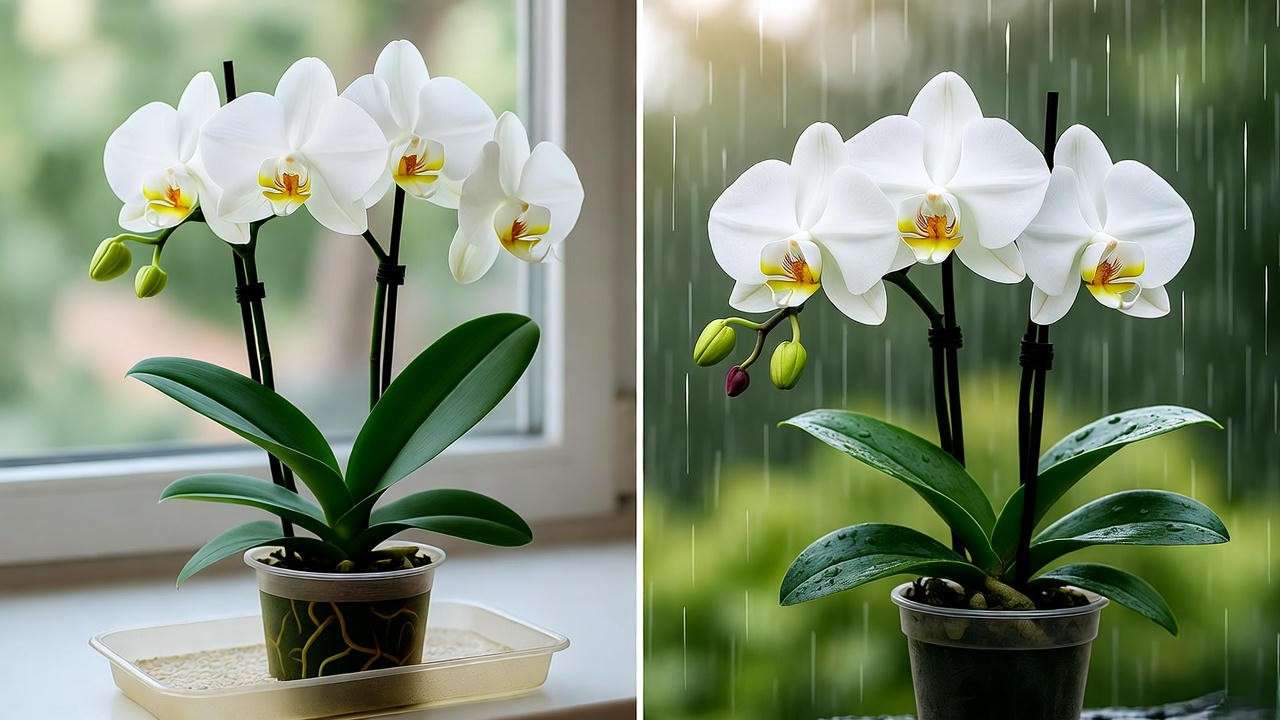
Potting Medium and Container Impact
The potting medium and container type influence how quickly moisture evaporates:
- Bark: Dries out faster, requiring more frequent watering (every 5–7 days).
- Sphagnum moss: Retains moisture longer, so water every 10–14 days.
- Clear pots: Allow you to monitor root color and moisture levels easily.
- Ceramic pots: Look decorative but hide roots, so use a skewer to check moisture.
Adjusting for Climate and Seasons
- Dry climates: Boost humidity with a pebble tray filled with water or a humidifier (aim for 50–70% humidity).
- Humid climates: Reduce watering to prevent root rot, especially in moss-based media.
- Seasonal shifts: In spring and summer, orchids grow actively and need more water. In fall and winter, reduce frequency as growth slows.
Expert Insight: A hygrometer is a game-changer for monitoring humidity. I keep one near my orchids to ensure ideal conditions year-round.
Advanced Watering Tips for Orchid Enthusiasts 🌟
Once you’ve mastered the basics of how to water an orchid plant, it’s time to elevate your care routine with advanced techniques. These tips, honed from years of orchid cultivation, will help you fine-tune your watering practices for healthier plants and more spectacular blooms.
Fertilizing While Watering
Watering sessions are the perfect opportunity to feed your orchid, but it requires a delicate balance. Orchids need nutrients to thrive, but over-fertilizing can burn roots or cause salt buildup.
- The “weakly, weekly” method: Use a balanced orchid fertilizer (e.g., 20-20-20) diluted to ¼ strength and apply it weekly during watering. This provides consistent, gentle nutrition.
- Choosing the right fertilizer: Opt for urea-free formulas designed for orchids, as urea can harm epiphytic roots. Brands like Dyna-Gro or Miracle-Gro Orchid Food are popular among growers.
- Flushing the pot: Every 4–6 weeks, water thoroughly with plain water to flush out accumulated salts, which can damage roots over time.
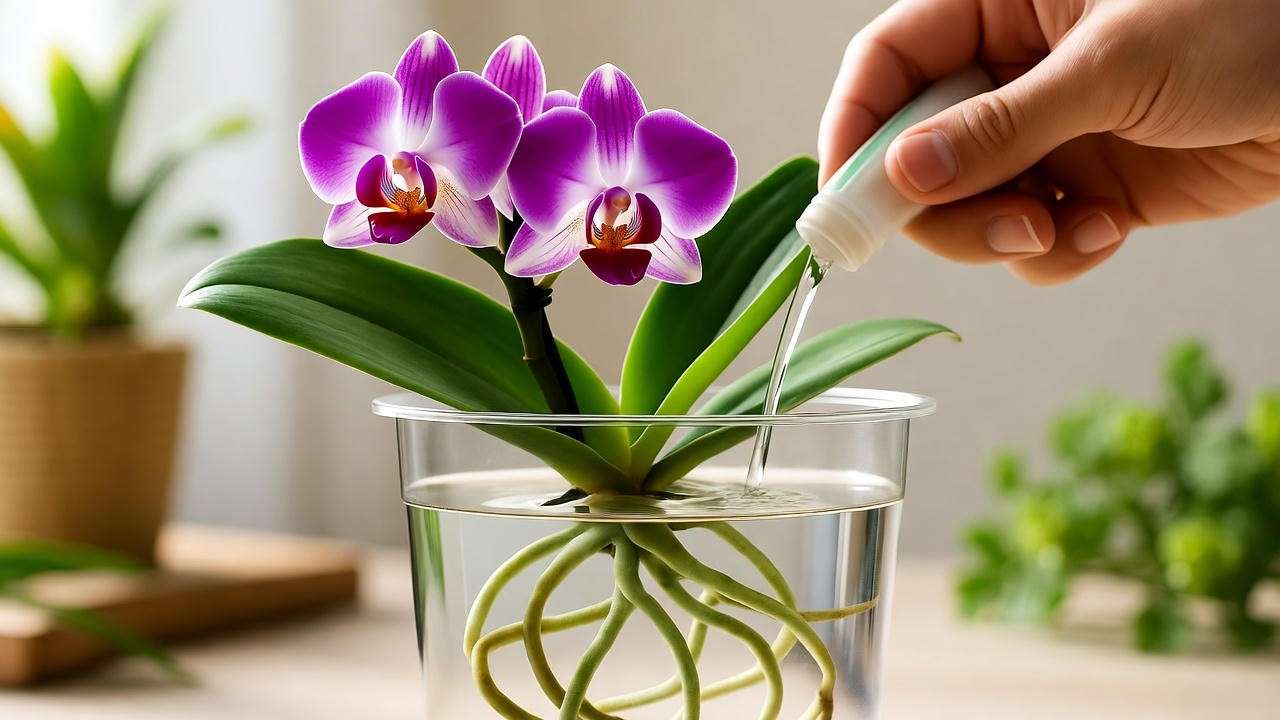
For instance, I fertilize my Phalaenopsis during every other watering in spring, using a ¼-strength solution, and flush the pot monthly to keep the medium clean. This routine has led to consistent blooms year after year.
Reviving an Overwatered or Underwatered Orchid
Even the best plant parents slip up sometimes. Here’s how to rescue an orchid suffering from watering mishaps:
- Overwatered orchid:
- Signs: Mushy, black, or brown roots; yellowing leaves; a soggy medium.
- Solution: Remove the orchid from its pot, trim away rotten roots with sterilized scissors, and repot in fresh, dry bark or moss. Water sparingly until new growth appears.
- Example: A client’s Cattleya was nearly lost to root rot but recovered after repotting and a month of careful watering.
- Underwatered orchid:
- Signs: Wrinkled leaves, shriveled roots, and no new growth.
- Solution: Soak the pot in water for 15–20 minutes to rehydrate gradually. Increase watering frequency slightly, but avoid flooding. Mist roots lightly for a quick hydration boost.
Pro Tip: If you’re unsure whether your orchid is over- or underwatered, inspect the roots. Healthy roots are firm and green or silvery; unhealthy ones are mushy or brittle.
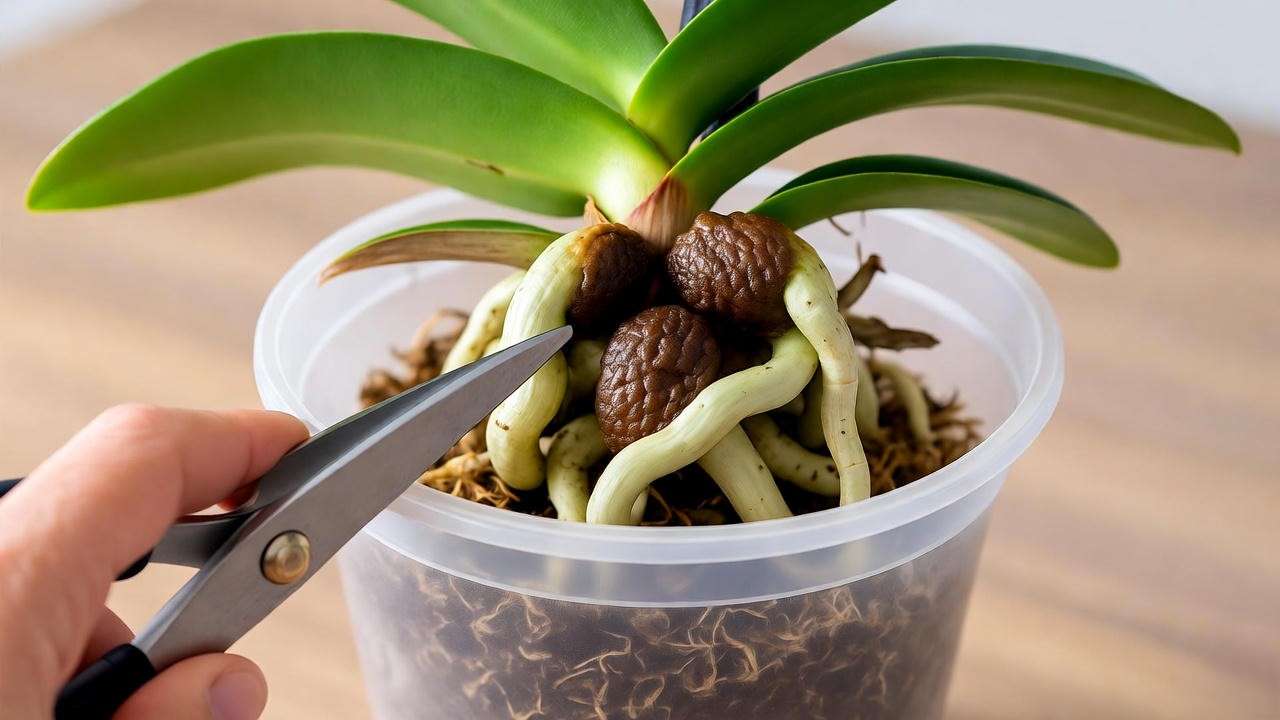
Watering for Blooms
Proper watering directly impacts your orchid’s ability to produce stunning flowers.
- Encouraging blooms: During the growth phase (spring/summer), consistent watering supports flower spike development. Ensure the medium dries slightly between waterings to mimic natural cycles.
- Timing for bloom cycles: Once a flower spike forms, maintain steady moisture without overdoing it, as soggy conditions can cause buds to drop.
- Post-bloom care: After blooms fade, reduce watering slightly to let the plant rest, preparing it for the next cycle.
For example, my Dendrobium bloomed twice in one year after I adjusted watering to align with its growth spurts, ensuring just enough moisture to support new spikes.
FAQs About Watering Orchids ❓
To address common reader questions and boost SEO, here are answers to frequently asked questions about orchid watering, based on real-world grower experiences.
Q1: How do I know if I’m overwatering my orchid?
- Answer: Look for yellowing leaves, mushy or black roots, or a constantly wet potting medium. If the roots feel soft or the pot smells musty, you’re likely overwatering. Solution: Let the medium dry out, trim damaged roots, and adjust your routine to water only when roots are silvery.
Q2: Can I use tap water for my orchid?
- Answer: Tap water is often fine, but let it sit for 24 hours to remove chlorine. If your tap water is high in minerals, switch to rainwater or distilled water to prevent buildup, which can harm roots over time.
Q3: Should I water my orchid if it’s not blooming?
- Answer: Yes, but reduce frequency. Non-blooming orchids (in their rest phase) need less water, typically every 10–14 days. Check the roots and medium to avoid overwatering during this dormant period.
Q4: How do I water an orchid in a decorative pot with no drainage?
- Answer: Remove the orchid from the decorative pot, water it in a pot with drainage holes, and let it drain completely before returning it. Alternatively, use a small amount of water and tilt the pot to remove excess to prevent pooling.
Q5: What’s the best time of day to water orchids?
- Answer: Water in the morning to allow excess moisture to evaporate during the day, reducing the risk of fungal growth. Avoid watering at night, as damp conditions overnight can harm the plant.
Conclusion: Your Path to Thriving Orchids 🌺
Watering an orchid plant may seem daunting, but with the right knowledge, it’s a rewarding skill that unlocks lush, vibrant blooms. By watering based on your orchid’s needs — not a rigid schedule — using proper techniques, and avoiding common mistakes, you’ll transform your orchids into stunning focal points. Whether you’re nurturing a Phalaenopsis or a Cattleya, these expert tips will guide you to success. Start observing your orchid’s roots, adjust for your environment, and watch your plant thrive!
Have a question or a success story to share? Drop it in the comments below or try these watering tips today. Your orchids will thank you with dazzling flowers! 🌸

